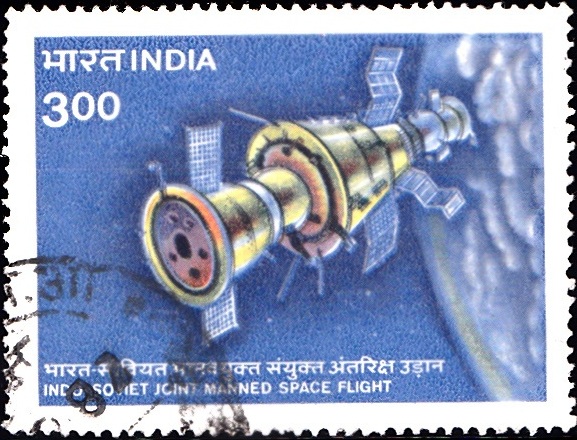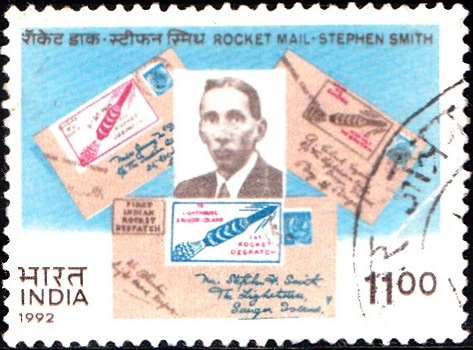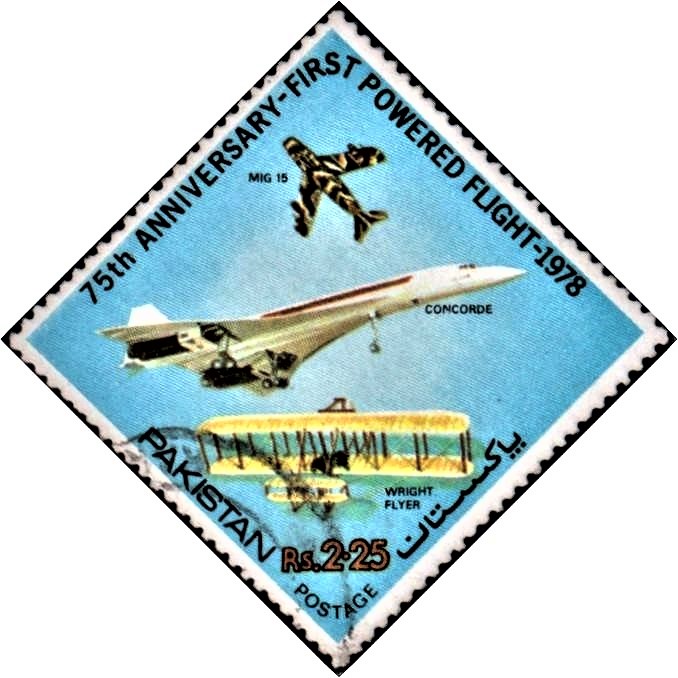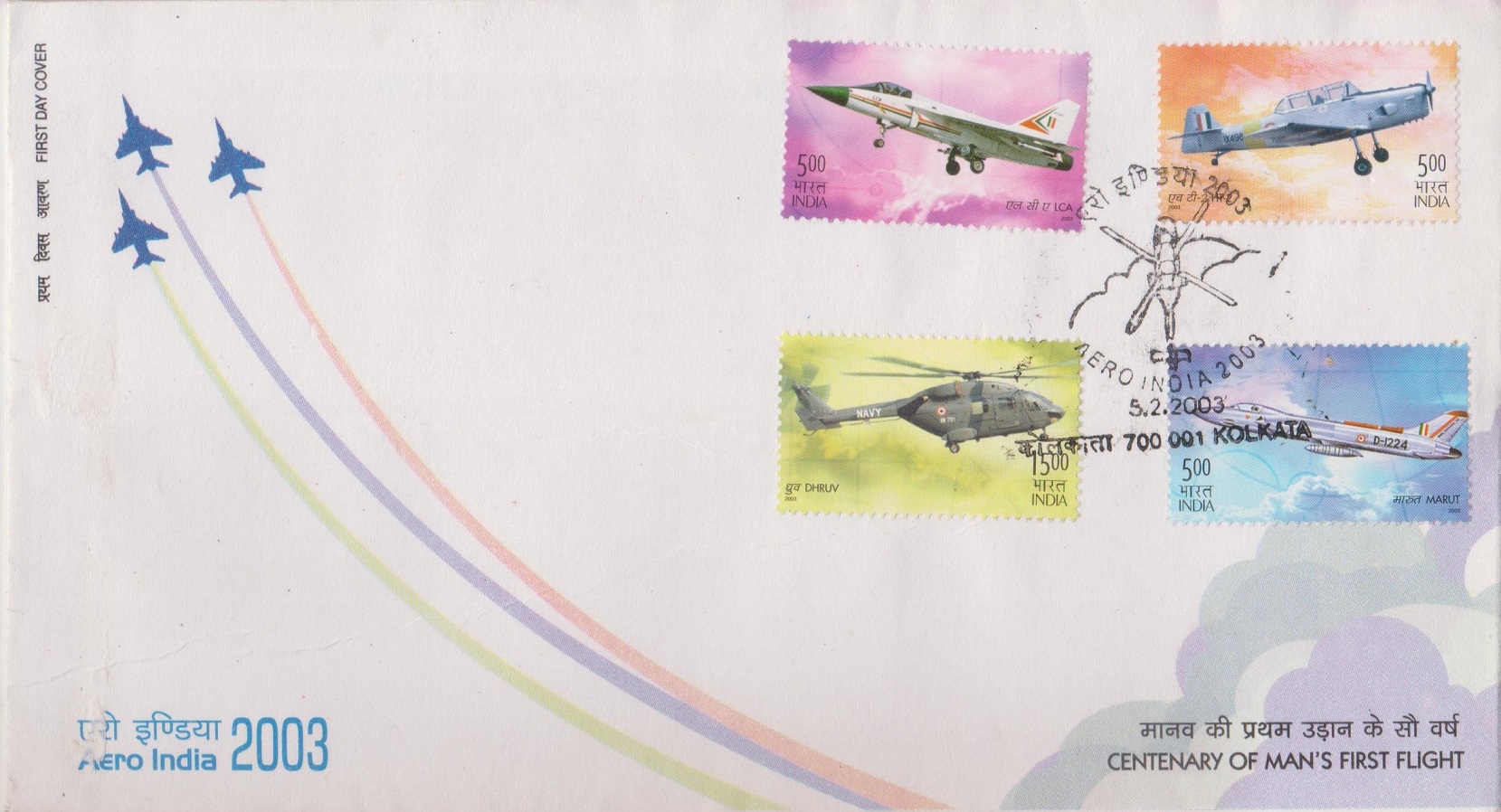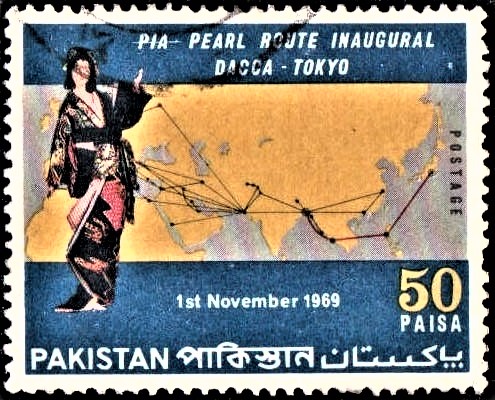
Pakistan on 1919 England to Australia flight
A commemorative postage stamp on the 50th Anniversary of First Aeroplane Flight from Great Britain to Australia (1919–1969) :
 Issued by Pakistan
Issued by Pakistan
Issued on Dec 2, 1969
Issued for : In March 1919 the Australian Government offered a prize of £ 10,000 for the first aeroplane to fly from England to Australia. The Air Race was won by the Vickers Vimy biplane commanded by Sir Ross Smith who took off from England on November 12, 1919 and reached Australia on December 10, 1919 after making brief stop-overs at various places including Karachi. The 50th Anniversary of this epic journey is being celebrated this year by a special re-enactment flight which will follow as closely as possible the route flown by Sir Ross Smith in 1919. To commemorate the occasion, Pakistan Post Office is issuing a postage stamp of 50-Paisa denomination on December 2, 1969, the date on which the re-enactment flight from London is scheduled to land at Karachi en-route to Australia.
Design : The format of the stamp is rectangular and horizontal. The “Vickers Vimy” which was the first aeroplane to reach Australia from England via Karachi in 1919 forms the central part of the design. The Karachi Airport building as it existed at that time has been shown in the back panel. The colour of the aeroplane is brown and black and the airport building has been shown in light brown against a pale blue background. The caption on the top of the stamp reads “50th Anniversary of First Aeroplane Flight England-Australia (1919-1969)” which is in red colour. The value “50” on the right side of the stamp as well as the dots pin-pointing London to Darwin is indicated in reverse. The words “Paisa” and “Postage” on the right side of the stamp, the date of issue of the commemorative “2-12-1969” and the words “London”, “Karachi Airport” and “Darwin” are in black.
A dark blue panel at the bottom bears the word “Pakistan” in English, Urdu and Bengali in reverse.
Type : Stamp, Postal Used
Denomination : 50 Paisa
Colour : Blue, red, black and brown
Size of stamp : 41 x 33.1 mm.
Size of print : 38 x 30.1 mm.
Perforation gauge : 13 x 13½ (C)
Quantity printed : 10,00,000
Number of stamps in each sheet : 50
Process of printing : Photogravure
Printers : The Pakistan Security Printing Corporation Ltd., Karachi
About :
- The Air Race was open upto the 31st December, 1919 and the flight was to be completed within 30 days of leaving England. In all six aircrafts participated in it. A gallant Frenchman named Etienne Poulet also took off from Paris during this period planning to accomplish the first flight from Europe to Australia. He was, of course, not eligible to compete for the prize. Poulet had left Paris on October 14, 1919, but the Vickers Vimy did not leave London until November 12, which was almost a month later. Another Australian aircraft with a crew of two had left London three weeks before the Vimy but they were snowbound in a very wintry Europe.
- When Captain Smith accompanied by his brother Lieut. Keith Smith and two mechanics Sergeants Bennett and Shiers left London the weather was entirely unsuitable for flying and the forecast was most discouraging. This did not deter Capt. Smith who was anxious to get on the trail of Poulet. The falling snow made visibility so poor that the Vimy knocked down the camera equipment of an optimistic photographer who had contravened instructions by setting up his apparatus in the haze at the end of the runway.
- After they left England the Vimy crew found that the weather was becoming even worse, as it forced them to an altitude of 8,000 feet at which height their lunch of sandwiches was frozen. When they arrived at Lyons in France, the ground staff were amazed that an aeroplane had flown from England in such shocking weather conditions. The snow and rain hindered their progress through Europe and on some occasions the airstrip surfaces were so bad that Bennett was forced to weigh down the tail of the aircraft during take off and quickly clamber back into the cockpit as the Vimy became airborne.
- On November 23, 1919, the Vimy reached Bander Abbas on the Persian Gulf. They left next day at 7 A.M. for the 730 mile flight to Karachi. The journey took eight and a half hours and they landed at Karachi on November 24. The airmen had a very pleasant time in Karachi where they stayed over night. The crew were specially over-joyed with the news they received in Karachi that Poulet was at Delhi, only one day’s flying away from them. They were hopeful of overtaking him but Poulet stayed ahead of the Vimy and became the first man to land an aeroplane in Burma, when he alighted at Akyab.
- At 7.40 A.M. on November 25, the Vickers Vimy took off from Karachi and circled the city several times to enable the local residents to have a better look at the aircraft which was quite huge by comparison to others.
- It was at Akyub in Burma that the Vickers Vimy caught up with Poulet on November 29. The two aircrafts left Akyub on the same day, the Vickers Vimy being one hour after Poulet, but due to its high power the Vimy reached Rangoon before Poulet. While Poulet experienced trouble in Moulmein, the Vimy forged ahead to reach Darwin on December 10, 1919 with just two days to spare and Capt. Smith and his crew won the £ 10,000 prize.
- The Vimy crew carried commemorative airmail from London and other letters were handed over to the then Australian Prime Minister in Melbourne. A commemorative stamp was also prepared by the Government of Australia and affixed to all letters which received a souvenir postmark.
- In all the countries visited by the Vimy in 1919, souvenir philatelic airmails will be uplifted by the re-enactment aircraft which is scheduled to reach Karachi on December 5, 1969. Philatelic airmail from Pakistan will be uplifted by the aircraft and all mails will be back-stamped in Melbourne by a special commemorative stamp.
- Issued by the Director-General, Pakistan Post Office, Karachi.


